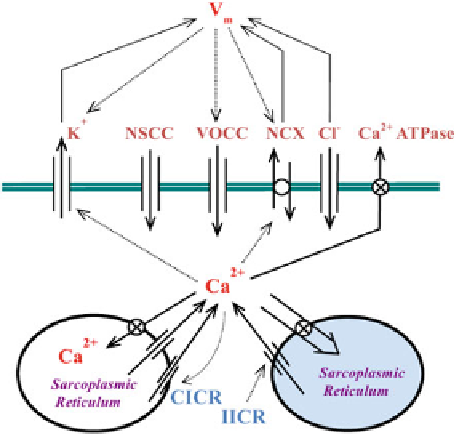Biomedical Engineering Reference
In-Depth Information
Fig. 1
Schematic of a SMC
illustrating the coupling
between the store-mediated
intracellular
Ca
2
+
oscillator
and membrane potential
fluctuations due to ionic
transport mechanisms across
the cellular membrane. The
system of ordinary differential
equations describing these
processes is presented below
1.2.3 The Role of the Endothelium
Through their direct and continuous contact to blood flow, ECs are exposed to the
action and combined effect of both mechanical forces and biochemical stimulation.
Electrical and chemical signalling between endothelial and SM cells contribute to
arterial function via two primary interrelated mechanisms. Longitudinal propaga-
tion of dilations-constrictions along the vessel wall constitutes one of these, while
the other comprises the effects of the endothelium-derived hyperpolarization factor
(EDHF), in which transmission of endothelial hyperpolarization to the SM medi-
ates relaxation. Both pathways are dependent on direct intercellular coupling via gap
junctions, allowing the diffusion of ions and small molecules (1kDa in size) and con-
ferring electrical continuity between coupled cells [
23
,
24
]. The role of the endothe-
lium in vasomotion nevertheless remains unclear. Some studies reported rhythmic
contractions in the absence of an intact endothelium, whereas others claimed that its
presence is needed for synchronization [
25
-
28
]. Such apparently paradoxical find-
ings may reflect the unpredictability that is characteristic of nonlinear systems, and
can potentially be clarified by further modelling studies.
Flow Regulation of Agonist-C a
2
+
Coupling
Although the results presented below do not include any coupling between endothe-
lial and SM cells, future work will address this point, in addition to considering
the effects of mass transport on mobilization of endothelial
Ca
2
+
]
i
. Using adenine
[

